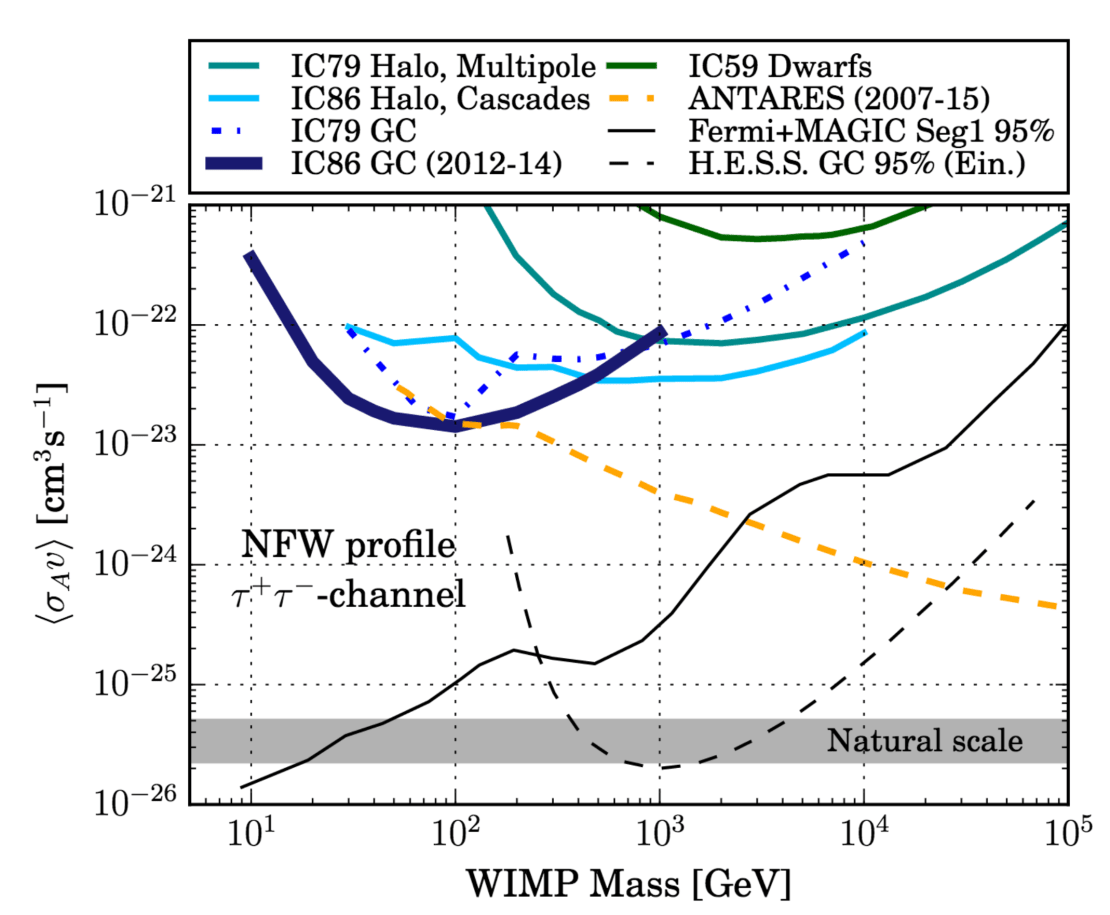Studies aimed at understanding the nature and origin of dark matter include experiments in astronomy, astrophysics and particle physics. Astronomical observations point to the existence of dark matter in large amounts and in many cosmic environments, including the Milky Way. However, at the same time, the international quest to detect a dark matter interaction has so far been unsuccessful.
IceCube has proven to be a champion detector for indirect searches of dark matter using neutrinos. As the amount of data grows and a better understanding of the detector allows making evermore precise measurements, the IceCube Collaboration continues exploring a vast range of dark matter energies and decay channels. In the most recent study, the collaboration sets the best limits on a neutrino signal from dark matter particles with masses between 10 and 100 GeV. These results have recently been submitted to the European Physical Journal C.

Searches for dark matter usually focus on a generic candidate, called a weakly interacting massive particle, or WIMP. Physicists expect WIMPs to interact with other matter particles or to self-annihilate, producing a cascade of known particles, which for many channels and energies include neutrinos that can be detected on Earth. If this is the case, a neutrino detector on Earth is expected to detect an excess of neutrinos related to the distribution of dark matter in our galaxy. A similar signal is expected for photons.
IceCube researchers have looked for neutrinos produced by dark matter self-annihilations in and around the center of the galaxy, based on a spherical dark-matter halo profile, using three years of DeepCore data. The larger IceCube volume provided a veto for background events. DeepCore is a denser infill array inside IceCube that allows the detection of neutrinos down to 10 GeV. Low-energy particles in IceCube are mostly of atmospheric origin, i.e., muons and neutrinos produced by the interaction of cosmic rays in the atmosphere. However, many dark matter signatures would also feature neutrinos with energies below a TeV.
In this analysis, IceCube has searched for WIMPs with masses from 10 to 1000 GeV, looking for neutrinos that resulted from the dark matter self-annihilation into b quarks, W bosons, muons or taus, or directly to neutrinos.
“The enormous size of IceCube allows the rare detection of high-energy neutrinos, but it is also essential for the detection of neutrinos at lower energies as it serves to identify incoming muons produced in cosmic ray air showers, which is a major challenge in searching for a signal from the Southern Hemisphere,” explains Morten Medici, a postdoctoral researcher at the Niels Bohr Institute in Denmark and corresponding author of this study.
A thorough selection allowed reducing the atmospheric muon background by seven orders of magnitude while keeping 6% of the simulated signal, and thus providing a favorable signal/background ratio. The searches included two different models for the dark matter halo profile of the Milky Way, five dark matter annihilation channels, and 11 values of the WIMP mass between 10 GeV and one TeV.
“Using improvements in the IceCube software specialized for reconstructing neutrinos with energies down to 1 GeV, we were able to improve the sensitivity of IceCube up to an order of magnitude for WIMPs with masses below 1000 GeV,” adds Morten.
None of the searches observed an excess of neutrinos, but these measurements allowed setting new upper limits on the pair-annihilation cross section for each channel and mass, which resulted in the best such limits of a neutrino experiment for the annihilation into taus and WIMP masses between 10 and 100 GeV.
+ info “Search for Neutrinos from Dark Matter Self-Annihilations in the center of the Milky Way with 3 years of IceCube/DeepCore,” The IceCube Collaboration: M. G. Aartsen et al., European Physical Journal C77 (2017) 627, link.springer.com arxiv.org/abs/1705.08103